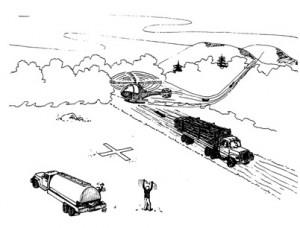BACKGROUND: A helicopter drip-torch burning operation was set up in a wide turnout of a main logging road in the Inland West. The operation included a fuel truck, a batch truck, and the supporting ground crew. The weather was clear with good visibility. The incident occurred at mid-day on the first day at this landing. Traffic was expected to pass by the operation. The torch-fuel mixing crew was directing the incoming helicopter in preparation to refuel the torch.
A loaded log truck approached the landing area. The helicopter pilot did not see the oncoming log truck, and the log truck proceeded through the work area apparently not seeing the landing helicopter.
PERSONAL CHARACTERISTICS: The “prescribed burn” contractor had been in business for 16 years, with 15 years’ experience in helicopter burning operations. The pilot and ground crew were experienced and considered fully trained. All ground crew members wore highly visible attire as recommended for burning and helicopter operations.
NEAR MISS: The helicopter laid the drip torch down and was landing along the road when the loaded truck approached. The truck driver did not acknowledge the approaching helicopter, ground crew, or other activity and continued through the landing area. At the last moment, a member of the landing crew noticed the situation and waved the helicopter off, narrowly averting a collision. The truck passed dangerously close to ground crew members, as well.
CAUSE OF NEAR MISS: The ground crew assumed that ongoing helicopter operations would be obvious to approaching traffic. There were no signs, cones, barricades, flaggers, or other traffic control devices present. The truck driver did not slow down and look for hazards as he approached the congested area.
RECOMMENDATIONS FOR CORRECTION:
- Industrial aviation and support crews must anticipate that individuals unfamiliar with such operations and associated hazards may enter the work area.
- If possible, set up helicopter landings well away from traffic, and close entry roads.
- When operating on or near a traveled roadway, place signs and other traffic control devices. As appropriate, assign a flagger.
- Discuss site-specific safety hazards during a pre-work conference.
- Contact the trucking company to discuss the near miss.
 Courtesy of the Forest Resources Association: https://www.forestresources.org/
Courtesy of the Forest Resources Association: https://www.forestresources.org/
